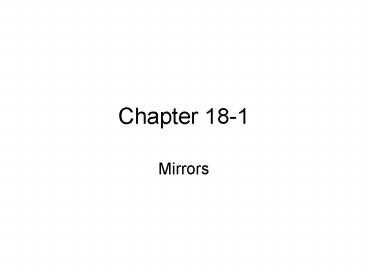Mirrors PowerPoint PPT Presentation
Title: Mirrors
1
Chapter 18-1
- Mirrors
2
Plane Mirror
- a flat, smooth surface
- light is reflected by regular reflection rather
than by diffuse reflection - Light rays are reflected with equal angles of
incidence and reflection.
3
Plane Mirror
- Produces a virtual image which appears to be an
equal distance behind the mirror. With a virtual
image, the light rays do not actually converge on
the point where the image appears. - The object and the image have the same size.
- They are pointing in the same direction, so the
image is an erect image. - Left and right are reversed which is to say the
front and back of the image are reversed.
4
If you blink your right eye, your mirror image
left eye blinks back at you
5
Concave Mirrors
- A concave mirror reflects light from its inner,
(caved in) surface. - The principal axis is the straight line
perpendicular to the surface of the mirror at its
center. - The focal point
- is the point where all rays parallel to the
principal axis meet. - It is half the distance between the mirror and
the center of curvature (C). - If you point the principal axis of a concave
mirror at the sun, all the rays (which are
parallel to each otherat infinity) will be
reflected through the focus - The distance from the focal point to the mirror
along the principal axis is the focal length, f,
of the mirror.
6
Real vs Virtual Images
- Real Image
- the rays actually converge and pass through the
image - it can be seen on a piece of paper or screen
- Virtual Image
- The rays do not converge at the location of the
virtual image - The virtual image cannot be projected on a screen
7
How to draw Ray Diagrams
- Draw the mirror, principal axis, a vertical line
where the principal axis touches the mirror, the
image, the focal point (F) and the center of
curvature (C).
Ray 1 (the parallel ray) is from the object to
the mirror parallel to the principal axis. The
reflected ray goes through the focal point Ray 2
(the focus ray) is from the object through the
focal point. The reflected ray is parallel to
the principal axis Where Ray 1 and Ray 2
intersect is the location of the image.
8
Possible scenarios for Concave Mirrors
Object Image
9
Lens/mirror equation If I do I die.
- f focal length
- do distance of object from mirror
- di distance of image from mirror
10
Magnification
- the ratio of the size of the image, hi ,
- to the size of the object, ho
or
11
b. How high is the image?
12
Virtual Images Formed by Concave Mirrors
13
Image defect in Concave Mirrors
- Spherical aberration
- Parallel Incident Light from outer edge of
spherical mirror fails to focus at a point - Fix Parabolic mirror
14
Convex Mirrors
- A convex mirror is a spherical mirror that
reflects light from its outer surface. - Rays reflected from a convex mirror always
diverge. - Focal length, f, is a negative number (because F
is behind the mirror) - di is negative because the image is behind the
mirror
- Convex mirrors do not form real images.
- Images are reduced in size and so appear far away
- Fisheye lens the image is small (reduced) but
wide ranging - (enlarged) field of view upright image,
virtual, reduced - (images seem farther away)
- Good for security mirrors rearview mirrors in
cars
15
Problem from Opening Page of Chap 18 in Textbook
- Four Butterflies but only one is real.
- Identify the images and the shape of lenses that
produced them
16
(No Transcript)
17
End 18-1

